 Technology peripherals
Technology peripherals
 AI
AI
 Don't wait for OpenAI, the world's first Sora-like one is open source first! All training details/model weights are fully disclosed and the cost is only $10,000
Don't wait for OpenAI, the world's first Sora-like one is open source first! All training details/model weights are fully disclosed and the cost is only $10,000
Don't wait for OpenAI, the world's first Sora-like one is open source first! All training details/model weights are fully disclosed and the cost is only $10,000
Not long ago, OpenAI Sora quickly became popular with its amazing video generation effects, highlighting the differences with other Vincent video models and becoming the focus of global attention.
Following the launch of the Sora training inference reproduction process with a 46% cost reduction 2 weeks ago, the Colossal-AI team fully open sourced the world's first Sora-like architecture video generation model " Open-Sora 1.0"——covers the entire training process, including data processing, all training details and model weights, and joins hands with global AI enthusiasts to promote a new era of video creation .
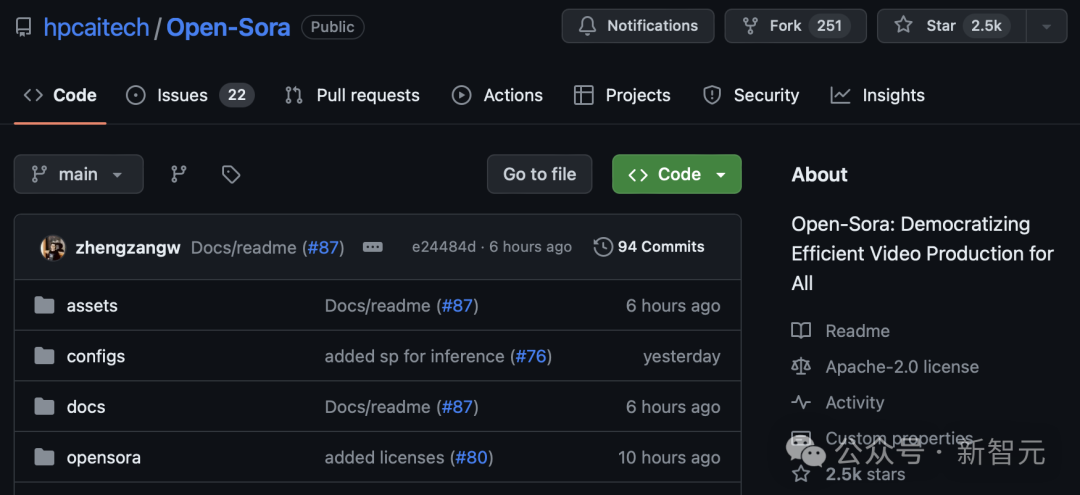
##Open-Sora open source address: https://github.com/hpcaitech/Open-Sora
For a sneak peek, let’s take a look at a Glimpse video of a bustling city generated by the "Open-Sora 1.0" model released by the Colossal-AI team.

A snapshot of the bustling city generated by Open-Sora 1.0
This is just the iceberg of Sora’s reproduction technology In the corner of the video, the Colossal-AI team has provided free access to the model architecture, trained model weights, all reproduced training details, data preprocessing process, demo display and detailed hands-on tutorial of Wensheng’s video. Open source on GitHub.
Xinzhiyuan contacted the team immediately and learned that they will continue to update Open-Sora related solutions and latest developments. Interested friends can stay tuned to Open-Sora’s open source community.

Next, we will deeply interpret the multiple key dimensions of the Sora recurrence plan. Including model architecture design, training reproduction plan, data preprocessing, model generation effect display and efficient training optimization strategy.
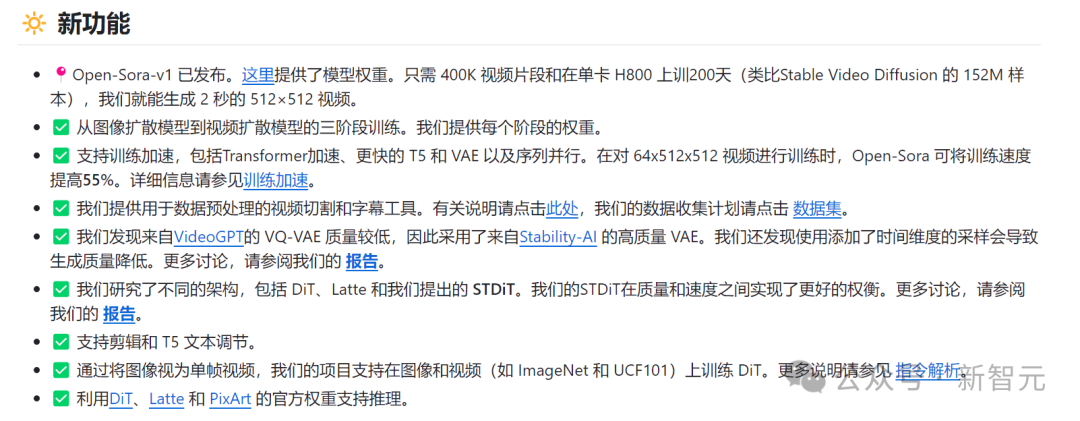
Model architecture design
The model adopts the currently popular Diffusion Transformer (DiT) [1] architecture.
The author team uses the high-quality open source Vincent graph model PixArt-α [2], which also uses the DiT architecture, as the base, introduces the temporal attention layer on this basis, and extends it to on video data.
Specifically, the entire architecture includes a pre-trained VAE, a text encoder, and a STDiT (Spatial Temporal Diffusion Transformer) model that utilizes the spatial-temporal attention mechanism.
Among them, the structure of each layer of STDiT is shown in the figure below. It uses a serial method to superimpose a one-dimensional temporal attention module on a two-dimensional spatial attention module to model temporal relationships.
After the temporal attention module, the cross-attention module is used to align the semantics of the text. Compared with the full attention mechanism, such a structure greatly reduces training and inference overhead.
Compared with the Latte [3] model, which also uses the spatial-temporal attention mechanism, STDiT can better utilize the weights of pre-trained image DiT, thereby improving the performance of video data. Continue training.
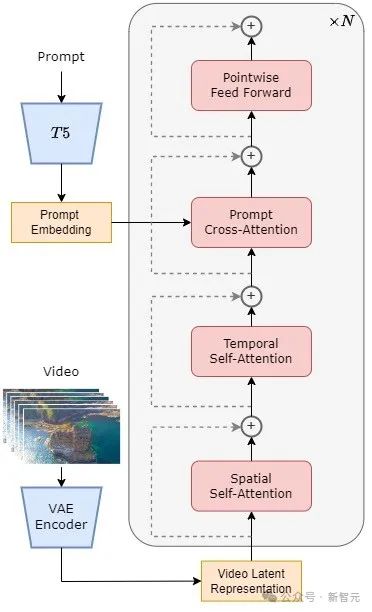
STDiT structure diagram
The training and inference process of the entire model is as follows. It is understood that in the training phase, the pre-trained Variational Autoencoder (VAE) encoder is first used to compress the video data, and then the STDiT diffusion model is trained together with text embedding in the compressed latent space.
In the inference stage, a Gaussian noise is randomly sampled from the latent space of the VAE and input into STDiT together with the prompt embedding to obtain the denoised features. Finally, it is input to the VAE decoder and decoded to obtain the video.

Model training process
Training recurrence plan
We learned from the team that Open-Sora’s recurrence plan refers to the Stable Video Diffusion (SVD) [3] work and includes three stages, namely:
1. Large-scale image pre-training;
2. Large-scale video pre-training;
3. Fine-tuning of high-quality video data.
Each stage will continue training based on the weights of the previous stage. Compared with single-stage training from scratch, multi-stage training achieves the goal of high-quality video generation more efficiently by gradually expanding data.

Three stages of training plan
First stage: large-scale image pre-training
#The first stage uses large-scale image pre-training and the mature Vincentian graph model to effectively reduce the cost of video pre-training.
The author team revealed to us that through the rich large-scale image data on the Internet and advanced grammatical technology, we can train a high-quality grammatical model, which will be used as the next Initialization weights for one-stage video pre-training.
At the same time, since there is currently no high-quality spatio-temporal VAE, they used the image VAE pre-trained by the Stable Diffusion [5] model. This strategy not only ensures the superior performance of the initial model, but also significantly reduces the overall cost of video pre-training.
The second stage: large-scale video pre-training
The second stage performs large-scale video pre-training to increase model generalization capabilities and effectively grasp the time series correlation of videos.
We understand that this stage requires the use of a large amount of video data for training to ensure the diversity of video themes, thereby increasing the generalization ability of the model. The second-stage model adds a temporal attention module to the first-stage Vincentian graph model to learn temporal relationships in videos.
The remaining modules are consistent with the first stage, and load the first stage weights as initialization, and initialize the output of the temporal attention module to zero to achieve more efficient and faster convergence.
The Colossal-AI team used the open source weights of PixArt-alpha[2] as the initialization of the second-stage STDiT model, and the T5[6] model as the text encoder. At the same time, they used a small resolution of 256x256 for pre-training, which further increased the convergence speed and reduced training costs.
The third stage: fine-tuning of high-quality video data
The third stage of high Quality video data is fine-tuned to significantly improve the quality of video generation.
The author team mentioned that the size of the video data used in the third stage is one order of magnitude less than that in the second stage, but the length, resolution and quality of the video are higher. By fine-tuning in this way, they achieved efficient scaling of video generation from short to long, from low to high resolution, and from low to high fidelity.
The author team stated that in the Open-Sora reproduction process, they used 64 H800 blocks for training.
The total training volume of the second stage is 2808 GPU hours, which is approximately US$7,000. The training volume of the third stage is 1920 GPU hours, which is about 4500 US dollars. After preliminary estimation, the entire training plan successfully controlled the Open-Sora reproduction process to about US$10,000.
Data preprocessing
In order to further reduce the threshold and complexity of Sora reproduction, the Colossal-AI team also provides The convenient video data preprocessing script allows you to easily start Sora recurrence pre-training, including downloading public video data sets, segmenting long videos into short video clips based on shot continuity, and using the open source large language model LLaVA [7] to generate detailed Prompt word.
The author team mentioned that the batch video title generation code they provided can annotate a video with two cards and 3 seconds, and the quality is close to GPT-4V. The resulting video/text pairs can be directly used for training.
With the open source code they provide on GitHub, we can easily and quickly generate the video/text pairs required for training on our own dataset, significantly reducing the complexity of starting Sora. The technical threshold and preliminary preparation of the current project.

Video/text pair automatically generated based on data preprocessing script
Model generation effect display
Let’s take a look at the actual video generation effect of Open-Sora. For example, let Open-Sora generate an aerial footage of sea water lapping against rocks on a cliff coast.
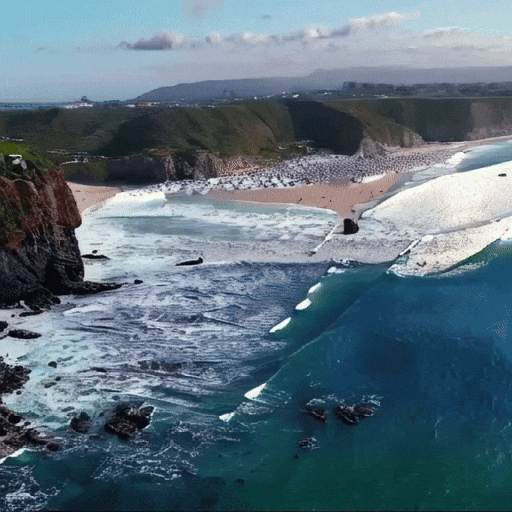
Let Open-Sora capture the magnificent bird's-eye view of mountains and waterfalls surging down from the cliffs and finally flowing into the lake.

In addition to going to the sky, you can also enter the sea. Simply enter prompt and let Open-Sora generate a shot of the underwater world. In the shot, a turtle is on a coral reef. Cruise leisurely.

Open-Sora can also show us the Milky Way with twinkling stars through time-lapse photography.

If you have more interesting ideas for video generation, you can visit the Open-Sora open source community to obtain model weights for free experience.
Link: https://github.com/hpcaitech/Open-Sora
It is worth noting that the author team mentioned on Github that the current version only uses 400K training data, and the model’s generation quality and ability to follow text need to be improved. For example, in the turtle video above, the resulting turtle has an extra leg. Open-Sora 1.0 is also not good at generating portraits and complex images.
The author team listed a series of plans to be done on Github, aiming to continuously solve existing defects and improve the quality of production.

Efficient training support
In addition to greatly reducing the technical threshold for Sora reproduction, it also improves the efficiency of video generation Regarding the quality in multiple dimensions such as duration, resolution, content, etc., the author team also provided the Colossal-AI acceleration system for efficient training support for Sora reproduction.
Through efficient training strategies such as operator optimization and hybrid parallelism, an acceleration effect of 1.55 times was achieved in the training of processing 64-frame, 512x512 resolution video.
At the same time, thanks to Colossal-AI’s heterogeneous memory management system, a 1-minute 1080p high-definition video training task can be performed without hindrance on a single server (8 x H800) .

In addition, in the report of the author team, we also found that the STDiT model architecture also showed excellent efficiency during training.
Compared with DiT, which uses a full attention mechanism, STDiT achieves an acceleration effect of up to 5 times as the number of frames increases, which is particularly critical in real-life tasks such as processing long video sequences.
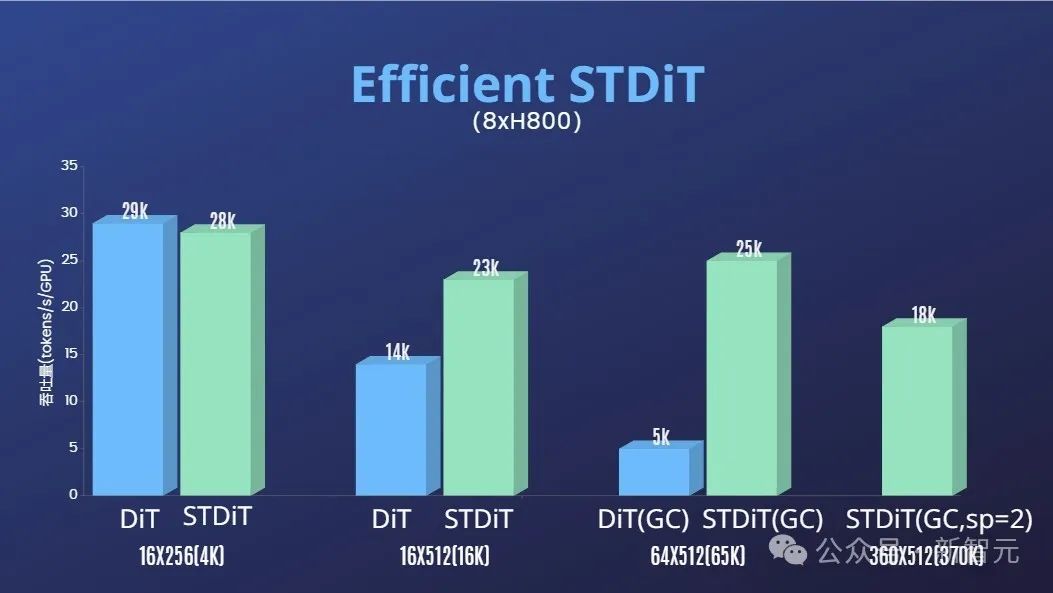
At a glance Open-Sora model video generation effect
HuanWelcome to continue to pay attention to the Open-Sora open source project: https://github.com/hpcaitech/Open-Sora
The author team mentioned that they The Open-Sora project will continue to be maintained and optimized, and it is expected to use more video training data to generate higher quality, longer video content, and support multi-resolution features to effectively promote the application of AI technology in movies, games, Implementation in advertising and other fields.
The above is the detailed content of Don't wait for OpenAI, the world's first Sora-like one is open source first! All training details/model weights are fully disclosed and the cost is only $10,000. For more information, please follow other related articles on the PHP Chinese website!

Hot AI Tools

Undresser.AI Undress
AI-powered app for creating realistic nude photos

AI Clothes Remover
Online AI tool for removing clothes from photos.

Undress AI Tool
Undress images for free

Clothoff.io
AI clothes remover

Video Face Swap
Swap faces in any video effortlessly with our completely free AI face swap tool!

Hot Article

Hot Tools

Notepad++7.3.1
Easy-to-use and free code editor

SublimeText3 Chinese version
Chinese version, very easy to use

Zend Studio 13.0.1
Powerful PHP integrated development environment

Dreamweaver CS6
Visual web development tools

SublimeText3 Mac version
God-level code editing software (SublimeText3)

Hot Topics
 WorldCoin (WLD) price forecast 2025-2031: Will WLD reach USD 4 by 2031?
Apr 21, 2025 pm 02:42 PM
WorldCoin (WLD) price forecast 2025-2031: Will WLD reach USD 4 by 2031?
Apr 21, 2025 pm 02:42 PM
WorldCoin (WLD) stands out in the cryptocurrency market with its unique biometric verification and privacy protection mechanisms, attracting the attention of many investors. WLD has performed outstandingly among altcoins with its innovative technologies, especially in combination with OpenAI artificial intelligence technology. But how will the digital assets behave in the next few years? Let's predict the future price of WLD together. The 2025 WLD price forecast is expected to achieve significant growth in WLD in 2025. Market analysis shows that the average WLD price may reach $1.31, with a maximum of $1.36. However, in a bear market, the price may fall to around $0.55. This growth expectation is mainly due to WorldCoin2.
 Why is the rise or fall of virtual currency prices? Why is the rise or fall of virtual currency prices?
Apr 21, 2025 am 08:57 AM
Why is the rise or fall of virtual currency prices? Why is the rise or fall of virtual currency prices?
Apr 21, 2025 am 08:57 AM
Factors of rising virtual currency prices include: 1. Increased market demand, 2. Decreased supply, 3. Stimulated positive news, 4. Optimistic market sentiment, 5. Macroeconomic environment; Decline factors include: 1. Decreased market demand, 2. Increased supply, 3. Strike of negative news, 4. Pessimistic market sentiment, 5. Macroeconomic environment.
 What does cross-chain transaction mean? What are the cross-chain transactions?
Apr 21, 2025 pm 11:39 PM
What does cross-chain transaction mean? What are the cross-chain transactions?
Apr 21, 2025 pm 11:39 PM
Exchanges that support cross-chain transactions: 1. Binance, 2. Uniswap, 3. SushiSwap, 4. Curve Finance, 5. Thorchain, 6. 1inch Exchange, 7. DLN Trade, these platforms support multi-chain asset transactions through various technologies.
 Aavenomics is a recommendation to modify the AAVE protocol token and introduce token repurchase, which has reached the quorum number of people.
Apr 21, 2025 pm 06:24 PM
Aavenomics is a recommendation to modify the AAVE protocol token and introduce token repurchase, which has reached the quorum number of people.
Apr 21, 2025 pm 06:24 PM
Aavenomics is a proposal to modify the AAVE protocol token and introduce token repos, which has implemented a quorum for AAVEDAO. Marc Zeller, founder of the AAVE Project Chain (ACI), announced this on X, noting that it marks a new era for the agreement. Marc Zeller, founder of the AAVE Chain Initiative (ACI), announced on X that the Aavenomics proposal includes modifying the AAVE protocol token and introducing token repos, has achieved a quorum for AAVEDAO. According to Zeller, this marks a new era for the agreement. AaveDao members voted overwhelmingly to support the proposal, which was 100 per week on Wednesday
 Ranking of leveraged exchanges in the currency circle The latest recommendations of the top ten leveraged exchanges in the currency circle
Apr 21, 2025 pm 11:24 PM
Ranking of leveraged exchanges in the currency circle The latest recommendations of the top ten leveraged exchanges in the currency circle
Apr 21, 2025 pm 11:24 PM
The platforms that have outstanding performance in leveraged trading, security and user experience in 2025 are: 1. OKX, suitable for high-frequency traders, providing up to 100 times leverage; 2. Binance, suitable for multi-currency traders around the world, providing 125 times high leverage; 3. Gate.io, suitable for professional derivatives players, providing 100 times leverage; 4. Bitget, suitable for novices and social traders, providing up to 100 times leverage; 5. Kraken, suitable for steady investors, providing 5 times leverage; 6. Bybit, suitable for altcoin explorers, providing 20 times leverage; 7. KuCoin, suitable for low-cost traders, providing 10 times leverage; 8. Bitfinex, suitable for senior play
 What are the hybrid blockchain trading platforms?
Apr 21, 2025 pm 11:36 PM
What are the hybrid blockchain trading platforms?
Apr 21, 2025 pm 11:36 PM
Suggestions for choosing a cryptocurrency exchange: 1. For liquidity requirements, priority is Binance, Gate.io or OKX, because of its order depth and strong volatility resistance. 2. Compliance and security, Coinbase, Kraken and Gemini have strict regulatory endorsement. 3. Innovative functions, KuCoin's soft staking and Bybit's derivative design are suitable for advanced users.
 The top ten free platform recommendations for real-time data on currency circle markets are released
Apr 22, 2025 am 08:12 AM
The top ten free platform recommendations for real-time data on currency circle markets are released
Apr 22, 2025 am 08:12 AM
Cryptocurrency data platforms suitable for beginners include CoinMarketCap and non-small trumpet. 1. CoinMarketCap provides global real-time price, market value, and trading volume rankings for novice and basic analysis needs. 2. The non-small quotation provides a Chinese-friendly interface, suitable for Chinese users to quickly screen low-risk potential projects.
 How to win KERNEL airdrop rewards on Binance Full process strategy
Apr 21, 2025 pm 01:03 PM
How to win KERNEL airdrop rewards on Binance Full process strategy
Apr 21, 2025 pm 01:03 PM
In the bustling world of cryptocurrencies, new opportunities always emerge. At present, KernelDAO (KERNEL) airdrop activity is attracting much attention and attracting the attention of many investors. So, what is the origin of this project? What benefits can BNB Holder get from it? Don't worry, the following will reveal it one by one for you.





